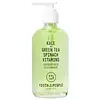What's inside
What's inside
 Key Ingredients
Key Ingredients

 Benefits
Benefits

 Concerns
Concerns

 Ingredients Side-by-side
Ingredients Side-by-side

Opuntia Ficus-Indica Stem Extract
Skin ConditioningGlycerin
HumectantPEG-6 Caprylic/Capric Glycerides
Emulsifying1,2-Hexanediol
Skin ConditioningOpuntia Ficus-Indica Seed Oil
EmollientSodium Hyaluronate
HumectantCitrus Aurantium Dulcis Fruit Extract
MaskingCitrus Medica Limonum Fruit Extract
Skin ConditioningCitrus Paradisi Fruit Extract
Skin ConditioningCitrus Aurantifolia Fruit Extract
Skin ConditioningCentella Asiatica Extract
CleansingBetula Alba Bud Extract
Skin ConditioningCorylus Avellana Bud Extract
Skin ConditioningOlea Europaea Bud Extract
AntioxidantJuglans Regia Leaf Extract
AbrasiveMelia Azadirachta Leaf Extract
Skin ConditioningMelia Azadirachta Flower Extract
Skin ConditioningEthylhexylglycerin
Skin ConditioningWater
Skin ConditioningPropanediol
SolventAlcohol
AntimicrobialButylene Glycol
HumectantDisodium EDTA
Parfum
MaskingOpuntia Ficus-Indica Stem Extract, Glycerin, PEG-6 Caprylic/Capric Glycerides, 1,2-Hexanediol, Opuntia Ficus-Indica Seed Oil, Sodium Hyaluronate, Citrus Aurantium Dulcis Fruit Extract, Citrus Medica Limonum Fruit Extract, Citrus Paradisi Fruit Extract, Citrus Aurantifolia Fruit Extract, Centella Asiatica Extract, Betula Alba Bud Extract, Corylus Avellana Bud Extract, Olea Europaea Bud Extract, Juglans Regia Leaf Extract, Melia Azadirachta Leaf Extract, Melia Azadirachta Flower Extract, Ethylhexylglycerin, Water, Propanediol, Alcohol, Butylene Glycol, Disodium EDTA, Parfum
Water
Skin ConditioningCocamidopropyl Hydroxysultaine
CleansingSodium Cocoyl Glutamate
CleansingSorbeth-230 Tetraoleate
EmulsifyingPolysorbate 20
EmulsifyingSodium Chloride
MaskingAloe Barbadensis Leaf Juice Powder
Skin ConditioningBrassica Oleracea Acephala Leaf Extract
HumectantSpinacia Oleracea Leaf Extract
Skin ConditioningCamellia Sinensis Leaf Extract
AntimicrobialMedicago Sativa Extract
TonicChamomilla Recutita Flower Extract
MaskingTetrahexyldecyl Ascorbate
AntioxidantGlycerin
HumectantPanthenol
Skin ConditioningTocopheryl Acetate
AntioxidantDecyl Glucoside
CleansingSorbitan Laurate
EmulsifyingTetrasodium Glutamate Diacetate
Gluconolactone
Skin ConditioningEthylhexylglycerin
Skin ConditioningMaltodextrin
AbsorbentCitric Acid
BufferingPhenoxyethanol
PreservativePotassium Sorbate
PreservativeSodium Benzoate
MaskingGardenia Jasminoides Fruit Extract
Cosmetic ColorantParfum
MaskingSodium Hydroxide
BufferingSodium Glycolate
BufferingSodium Formate
BufferingHexyl Cinnamal
PerfumingLinalool
PerfumingLimonene
PerfumingCI 75810
Cosmetic ColorantWater, Cocamidopropyl Hydroxysultaine, Sodium Cocoyl Glutamate, Sorbeth-230 Tetraoleate, Polysorbate 20, Sodium Chloride, Aloe Barbadensis Leaf Juice Powder, Brassica Oleracea Acephala Leaf Extract, Spinacia Oleracea Leaf Extract, Camellia Sinensis Leaf Extract, Medicago Sativa Extract, Chamomilla Recutita Flower Extract, Tetrahexyldecyl Ascorbate, Glycerin, Panthenol, Tocopheryl Acetate, Decyl Glucoside, Sorbitan Laurate, Tetrasodium Glutamate Diacetate, Gluconolactone, Ethylhexylglycerin, Maltodextrin, Citric Acid, Phenoxyethanol, Potassium Sorbate, Sodium Benzoate, Gardenia Jasminoides Fruit Extract, Parfum, Sodium Hydroxide, Sodium Glycolate, Sodium Formate, Hexyl Cinnamal, Linalool, Limonene, CI 75810
 Reviews
Reviews

Ingredients Explained
These ingredients are found in both products.
Ingredients higher up in an ingredient list are typically present in a larger amount.
Ethylhexylglycerin (we can't pronounce this either) is commonly used as a preservative and skin softener. It is derived from glyceryl.
You might see Ethylhexylglycerin often paired with other preservatives such as phenoxyethanol. Ethylhexylglycerin has been found to increase the effectiveness of these other preservatives.
Glycerin is already naturally found in your skin. It helps moisturize and protect your skin.
A study from 2016 found glycerin to be more effective as a humectant than AHAs and hyaluronic acid.
As a humectant, it helps the skin stay hydrated by pulling moisture to your skin. The low molecular weight of glycerin allows it to pull moisture into the deeper layers of your skin.
Hydrated skin improves your skin barrier; Your skin barrier helps protect against irritants and bacteria.
Glycerin has also been found to have antimicrobial and antiviral properties. Due to these properties, glycerin is often used in wound and burn treatments.
In cosmetics, glycerin is usually derived from plants such as soybean or palm. However, it can also be sourced from animals, such as tallow or animal fat.
This ingredient is organic, colorless, odorless, and non-toxic.
Glycerin is the name for this ingredient in American English. British English uses Glycerol/Glycerine.
Learn more about GlycerinParfum is a catch-all term for an ingredient or more that is used to give a scent to products.
Also called "fragrance", this ingredient can be a blend of hundreds of chemicals or plant oils. This means every product with "fragrance" or "parfum" in the ingredients list is a different mixture.
For instance, Habanolide is a proprietary trade name for a specific aroma chemical. When used as a fragrance ingredient in cosmetics, most aroma chemicals fall under the broad labeling category of “FRAGRANCE” or “PARFUM” according to EU and US regulations.
The term 'parfum' or 'fragrance' is not regulated in many countries. In many cases, it is up to the brand to define this term.
For instance, many brands choose to label themselves as "fragrance-free" because they are not using synthetic fragrances. However, their products may still contain ingredients such as essential oils that are considered a fragrance by INCI standards.
One example is Calendula flower extract. Calendula is an essential oil that still imparts a scent or 'fragrance'.
Depending on the blend, the ingredients in the mixture can cause allergies and sensitivities on the skin. Some ingredients that are known EU allergens include linalool and citronellol.
Parfum can also be used to mask or cover an unpleasant scent.
The bottom line is: not all fragrances/parfum/ingredients are created equally. If you are worried about fragrances, we recommend taking a closer look at an ingredient. And of course, we always recommend speaking with a professional.
Learn more about ParfumWater. It's the most common cosmetic ingredient of all. You'll usually see it at the top of ingredient lists, meaning that it makes up the largest part of the product.
So why is it so popular? Water most often acts as a solvent - this means that it helps dissolve other ingredients into the formulation.
You'll also recognize water as that liquid we all need to stay alive. If you see this, drink a glass of water. Stay hydrated!
Learn more about Water